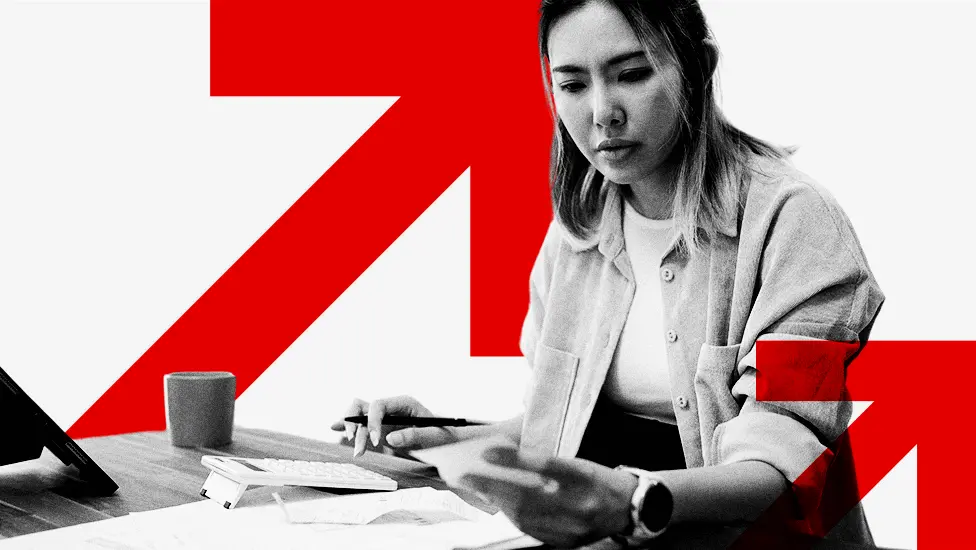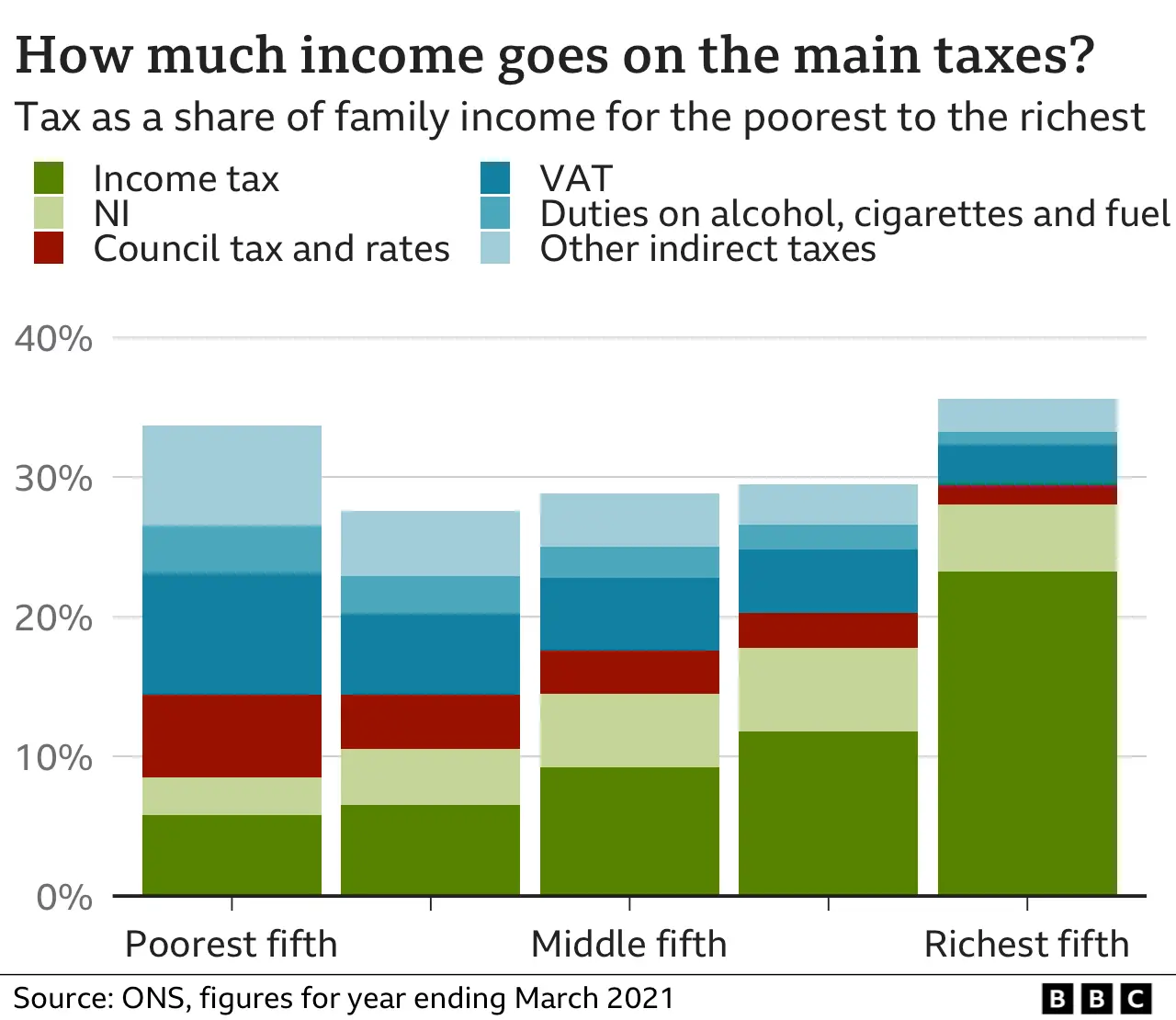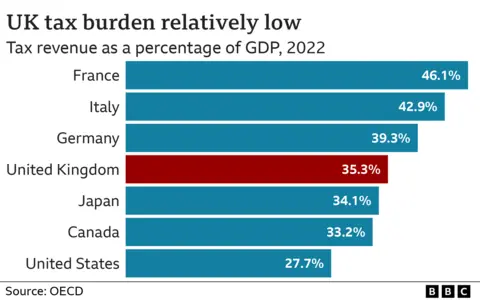National Insurance: What are NI and income tax rates and what's changing?
 Getty Images/BBC
Getty Images/BBCThe amount of National Insurance (NI) paid by employers goes up on 6 April.
For workers, the main rates of NI and income tax are not increasing. However, many people will pay more tax overall because the points at which people start paying - or move to higher rates - have not increased in line with inflation.
What is National Insurance and what does it pay for?
The government uses National Insurance contributions (NICs) to pay for benefits and to help fund the NHS.
It is paid by employees, employers and the self-employed across the UK. Those over the state pension age do not pay it, even if they are working.
Eligibility for some benefits, including the state pension, depends on the NICs you make across your working life.
How much do employers pay in National Insurance?
At the moment businesses pay a rate of 13.8% on employees' earnings above £9,100 a year.
From Sunday 6 April, employers will have to pay NI at 15% on salaries above £5,000.
The employment allowance - the amount employers can claim back from their NI bill - will increase from £5,000 to £10,500.
The government said the changes would eventually raise £25bn a year.
How much do employees pay in National Insurance?
Workers start paying NI when they turn 16 and earn more than £242 a week, or have self-employed profits of more than £12,570 a year.
The starting rate for NI for 27 million employees fell twice in 2024: from 12% to 10%, and then again to 8%.
The previous Conservative government said that the two cuts were worth about £900 a year for a worker earning £35,000.
For the self-employed, Class 4 NI contributions on all earnings between £12,570 and £50,270 fell from 9% to 6%. This was said to be worth £350 to a self-employed person earning £28,200.
Self-employed workers also no longer have to pay a separate category of NI called Class 2 contributions.
The NI rate on income and profits above £50,270 remains at 2% for all workers.
What are the current income tax rates?
Income tax is paid on earnings from employment and profits from self-employment.
It is also paid on some benefits and pensions, income from renting out property, and returns from savings and investments above certain limits.
The basic rate is 20% and is paid on annual earnings between £12,571 and £50,270.
The higher rate is 40%, and is paid on earnings between £50,271 and £125,140.
Once you earn more than £100,000, you also start losing the £12,570 tax-free personal allowance. You lose £1 of your personal allowance for every £2 that your income goes above £100,000.
Anyone earning more than £125,140 a year no longer has any tax-free personal allowance.
An additional rate of income tax of 45% is paid on all earnings above £125,140 a year.
These rates apply in England, Wales and Northern Ireland.
Some income tax rates are different in Scotland, where a new 45% band took effect in April 2024. At the same time the top rate also rose from 47% to 48%.
What is happening to NI and income tax thresholds and why do they matter?
Millions are paying more tax overall because of changes to the tax thresholds.
These are the income levels at which people start paying NI or income tax, or have to pay higher rates.
These used to rise every year in line with inflation.
However, the previous Conservative government froze the NI threshold and tax-free personal allowance at £12,570 until 2028. Higher-rate tax will continue to kick in for earnings above £50,270.
Freezing the thresholds means that more people start paying tax and NI as their wages increase, and more people pay higher rates.
According to the Institute for Fiscal Studies (IFS) think thank, the freeze cancels out the benefits of the NI cuts for some workers.
In the 2024-25 tax year, it says an average earner would have a tax cut of about £340 - from the combined tax changes - and people earning between £26,000 and £60,000 would be better off.
But by 2027, the average earner would be only £140 better off - and only people earning between £32,000 and £55,000 a year would still benefit.
Who pays most in income tax?
For most families, income tax is the single biggest tax they pay.
But for less well-off households, a greater share of family income goes on taxes on spending, known as indirect taxes.
For the poorest fifth of households, VAT is the biggest single tax paid.

How do UK taxes compare with other countries like France and Germany?
You can look at the amount of tax raised as a proportion of the size of the economy, or GDP.
In 2022 - the most recent year for which international comparisons can be made - that figure was 35.3%.
That puts the UK right in the middle of the G7 group of big economies.

France, Italy and Germany tax more; Canada, Japan and the US tax less.
However, overall taxation in the UK is high compared with historical rates.
In its assessment of the 2025 Spring Statement, the OBR said tax as a share of GDP will continue to rise.
It expects this to hit a record high in 2027-2028 - when the government will collect 37.7p of every pound generated in the economy.
